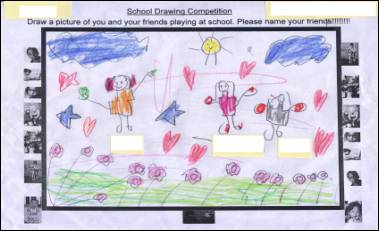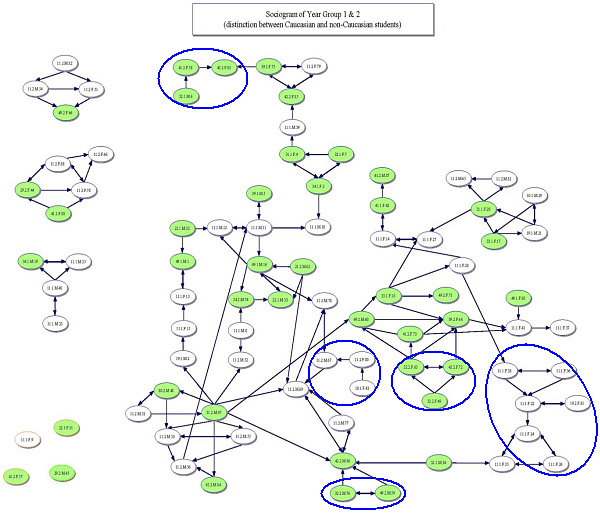Using children’s drawings to investigate racial inclusion in a school in England
Annita Eliadou, Wai Ming Lo, Sara Servio, Francis Simui
In this article, four University of Manchester students from Cyprus, Hong Kong, England and Zambia explain how they worked together to promote pupil voice in a Manchester primary school. They led a process of collaborative research about the issue of racial inclusion in the school.
As part of our Masters Degree course in Inclusive Education, we had to undertake a school-based inquiry research project. The school that participated in our research has been involved with the Manchester Inclusion Standard.
Racial inclusion is a key concern for the primary school where we did our research. Pupils come from 15 different ethnic backgrounds and speak 19 different languages; 57% of pupils are Caucasian and 43% are non-Caucasian. The school wanted to know if racial background is a barrier to students’ inclusion. The school is committed to continuously working to remove such barriers, and has received a gold award for its efforts.
Our research took four months, and we made eight visits to the school. We had regular meetings with the principal to ensure that the research was jointly planned. We focused on break times because we wanted to see if all pupils’ were included in play.
We asked all 233 pupils aged 5-11 to participate in the research through a drawing competition in which they could win prizes. They were asked to draw and name the friends they played with during break time. We used their drawings to identify all the play relationships that were happening and we plotted these in sociograms (see diagram). From this we could begin to see whether the pupils were playing in racially inclusive or in racially segregated groups. We also interviewed pupils about their views on their school lives and whether they felt included in school or not; 95% said their school is a friendly place.
“I like my school because I have a lot of friends here.”
“I like my school because my teachers are very friendly.”
We found that, overall, the school is racially inclusive, but some instances of racial segregation were happening among some of the pupils. This could become a barrier to their full inclusion in school life.
The school is already committed to using action research approaches to improve its practices. The findings from the pupil drawing activity could therefore be a starting point for further investigation into why this segregation is happening. As such, the school’s principal committed himself to taking action to address the instances of racial segregation identified among pupils.
Through this school-based inquiry research project we were able to promote pupil voice activities and help the school take forward its action research. The work highlighted for us how powerful and meaningful it can be to get children’s views on issues relating to the practices and policy-making that directly affect them. We discovered that inclusive education is really possible if all education stakeholders are willing to collaborate.

A pupil’s drawing. All the names have been covered to preserve anonymity.

This is a sociogram for Years 1 and 2. Each oval has a reference number written in it to represent a pupil who participated in the drawing competition. The arrows show each pupil’s preferred friends. Caucasian pupils are represented by white ovals and non-Caucasian by green ovals. The blue circles show where pupils appear to be playing only with peers from the same background as themselves (Caucasian or non-Caucasian).
What is school-based inquiry?
Education systems throughout the world are facing the challenge of learner diversity. Higher Education needs to respond to this challenge. In issue 10 of “Enabling Education”, Jamie Williams argued that teacher training and development should not happen in isolation – it should be part of system-wide change in the way schools are organised.
Masters students who study Inclusive Education at the University of Manchester are required to undertake a school-based inquiry research project. This innovatory course enables participants to develop skills and understanding so that they can take on leadership roles in relation to these challenges. It focuses on ways of bringing about change at the classroom, school and system level.
For more details about the M.Ed. in inclusive education, contact Susie Miles. Email: susie.miles@manchester.ac.uk or write to her via EENET.
The group of students who wrote this article won first prize in the University of Manchester’s annual ‘Student Team Working Awards’ in 2007 – in the category for post-graduate curricular entries. The judges said that the quality of their reflective writing was exceptionally high and that they were clear winners!
Francis Simui is a primary teacher trainer from Zambia. Wai Ming Lo is a school inspector from Hong Kong. Annita Eliadou is a graduate in Human Behavioural Biology from the University Of Toronto, Canada, originally from Cyprus. Sara Servio lives in England and is the parent of a child with autism. They can all be contacted via EENET.
